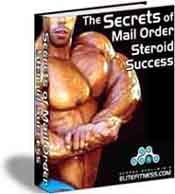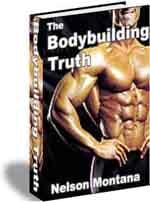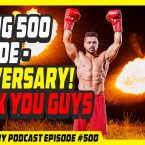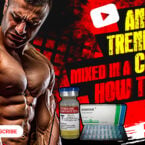Sign up to Get FREE Steroids, SARMS, Peptides eBooks
Als Bodybuilder, we all know that bulking is a hell of a lot more fun than cutting. Hingegen, Schließlich, everyone has to diet in order to burn the fat covering those muscles we\'ve worked so hard to build. In diesen Wochen EliteFitness.com News, Craig Ballantyne has interviewed Tom Venuto and gotten the diet guru to share many of his controversial fat burning techniques.
Getting Ripped to Shreds - the Tom Venuto Interview
Controversial Fat Loss Techniques, Weight Training For Fat Loss, And More! CB: Tom, you’ve written a great article called, “Risk to benefit ratios of extreme and controversial fat loss techniques”. Have your thoughts changed on any of the rankings since you wrote that article? TV: That article pretty much sums up my current thoughts about fat loss. The article looked at techniques for fat loss that are controversial, like not eating for 2-3 hours before going to bed or not eating carbs after a certain time of day, or doing early morning cardio on an empty stomach. Some experts recommend these methods; others strongly recommend avoiding them. Some say they work well; others say they don’t work at all. The main message I wanted to get across is that when you generalize by saying things like, “This technique is good”, that technique is bad, or “never do this,” “always do that,” you’re limiting yourself. I believe in the philosophy that the person who has the most flexibility and the most choices is the person with the most power to get results and to break past barriers (which unfortunately, are often self imposed by all or none thinking). |
Tom\'s educational background includes a B.Sc. degree in exercise science and he is also a "Certified Strength and Conditioning Specialist" (CSCS) from the National Strength & Conditioning Association (NSCA), the most prestigious personal trainer certification in the world. Tom is a lifetime natural bodybuilder and has won numerous competitions including three state and three regional titles, and runner-up at the Natural Mr. USA and Natural North America. Tom Venuto\'s e-book, Das Fett zu verbrennen, Feed The Muscle, is rated by Click Bank as the #1 fitness e-book und das #1 diet e-book on the Internet,with users in 107 countries. For Less Than the Cost of One Personal Training Session, You Can Now Learn The Inside Information That The World\'s Best Bodybuilders and Fitness Models Have Kept Shrouded in Secrecy For Decades! Look at it this way: The money you invest in this program is a drop in the bucket compared to the amount of money you\'ve probably wasted on useless supplements and fad diets that didn\'t even work. It\'s even less than any good personal trainer would charge for one hour! If You\'re Finished for Good With all the Weight Loss Fads, Pills and "Quick Fix Diets" That Have Failed You in the Past and You\'re Ready to Do it the Right Way, DANN IST ES! This is the Honest and Effective Fat Loss Solution You\'ve Been Searching For. For the complete inside story and to get a very special deal just for the readers of EliteFitness.com News, then you owe it to yourself to learn more. |
Instead of making generalizations, I prefer to approach training and nutrition from the viewpoint of personalization and risks versus benefits. If you think about it, all exercise has risks. Squatting has risks. Running has risks. Competing in sports has risks. You can’t avoid risks. Teufel, being alive has risks! The idea is to manage risks, not to try and eliminate them.
Take fasted cardio in the morning for example. Are there risks in using this technique in an attempt to accelerate fat loss? Ja, absolut. Cortisol is higher in the morning, so you are more catabolic and you might lose muscle. Does that mean there are no benefits and you should never use this technique? Nicht notwendig. Does doing cardio on an empty stomach guarantee you’re going to lose muscle? Nein, it only increases the possibility. Yet many trainers, strength coaches, athletes and bodybuilders approach techniques like these with “It’s good” or “It’s bad” with no shades of grey in between.
Die Wahrheit ist, the value of each technique depends very much on the context. I remember reading something Charles Poliquin wrote about how ridiculous it was to think about his “manly men” Sportler (as he called them), such as a 6 foot 5 Zoll 250 pound hockey player, doing any kind of conventional “aerobics.” That makes complete sense to me - in that context. If the athlete shows up after the off season carrying some undesired body fat, that weight can easily be shed with strength training and nutrition. Combine that with energy expended from practice time and no aerobics are necessary.
But does that mean “All aerobics are bad” or “Cardio is completely worthless.” Gut, wieder, it depends on the context. Bad or worthless when?, how much?, how intense?, what kind?, under what circumstances?, and for whom? Are we talking about a 55 year old sedentary woman with 35% Körperfett, an elite shot putter or a bodybuilder six weeks out from a competition?
I think these rigid all or none beliefs get formed gradually over a whole lifetime of experiences. We tend to collect our own personal biases and carry them along with us – I know I had to overcome my “pure bodybuilder” mentality and develop more flexibility in my approaches in order to really serve my non-bodybuilder clients the best. I specialize in fat loss – including nutrition, exercise and the psychological/emotional aspects - and my personal interest is bodybuilding. I don’t train people for sports, so I don’t have the perspective that most strength coaches do. Ähnlich, I imagine that many top strength coaches have developed an anti cardio bias from their experience working with power, speed and strength athletes who have always been told that aerobics kills your strength, and perhaps they generalize their beliefs to apply to everyone.
Bottom line, and the whole point of my article was that there are no absolutes, everything is context dependent.
CB: You rank “fasted cardio in the morning” as a high risk, high benefit activity for fat loss. Is this something that you use yourself or with clients?
TV: Because it’s high risk, it’s not necessarily a fat loss technique I recommend for everyone all the time. But I’m not afraid to use it and I believe it has benefits that can outweigh the risks, depending on the circumstances. I usually do fasted cardio in the morning about 8-12 weeks before a competition. But it depends on my weekly results. If I’m losing fat quickly and easily, I don’t need to use any high-risk techniques. Sometimes I’ll still do cardio in the morning, because I like doing it then, but I’ll have a whey protein drink or even a whole meal shortly beforehand.
I like to have an enormous amount of flexibility in my approach. If there’s a plateau in fat loss, I want to be able to dig into my bag of tricks and have a lot of stuff in there to pull out when I need it. If you only have one way and you get stuck, you have a problem. I don’t like rigid formulas, I like freedom to choose my approach according to how things are going.
CB: Most of my articles and interviews on my site promote interval training. Hingegen, traditional “cardio” has worked for many people. Ihrer Meinung nach, how does traditional cardio compare to interval training? What are the pro’s and con’s of each?
TV: Gut, I would agree with what Ian King wrote recently in one of his Q & A columns...
“As to whether you respond best to higher intensity interval training (HIIT) or lower intensity steady state training will depend a lot on you. You should try both (not concurrently) and compare.”
You simply have to experiment. Test and discover for yourself what works best. How do you know what works best if you don’t test it and measure the results? I don’t create my own program based on what the latest research says or what the popular trend is. I look at the research and pay attention to what’s going on at the “cutting edge,” but I don’t live and breathe by it. I do what produces results, Periode. There’s no doubt interval training is highly effective and supported with research. A great benefit of interval training for many people is time efficiency. Another is that it is mentally and physically engaging. Long duration conventional cardio can bore some people to tears.
My personal preference for my own fat loss cardio training is to work at the highest heart rate I can comfortably maintain for the entire duration of the workout, 20-30 Minuten. During pre-contest preparation, I often increase - in a progressive fashion - to as much as 30-45 Minuten, so my program to this day is primarily conventional cardio. I occasionally add in interval training more for variety than anything. I do like stair and hill sprinting though, and have done that for years. Seltsamerweise, I never really considered it “cardio” - I looked at it more as an adjunct to my leg workouts, although I’m sure I reaped some fat loss benefits from it.
We’ve all seen the research that compares low intensity, long duration cardio to HIIT, and we’ve seen the superiority of HIIT, but I’d like to see some research comparing, lets say, 20 minutes of HIIT with 30-45 minutes of challenging steady cardio at the top of your target heart zone. I find this type of cardio extremely effective and I imagine there’s a pretty substantial post workout afterburn in addition to the very large burn of fat calories during the workout. It’s nice to know, obwohl, that you CAN get a productive workout in just 20 minutes or less with HIIT.
Regardless of whether we’re talking about interval training or conventional cardio, you want to burn as many calories as you can given the time you have. I definitely don’t believe in the idea that low intensity cardio burns more total fat. That myth has clearly been debunked by the research, even though it still persists.
Naturally, beginners and de-conditioned people need to build some kind of fitness base before doing the really high intensity stuff. HIIT can be risky for certain people. Simple conventional cardio like walking is fantastic for the elderly and overweight, although cardio shouldn’t take precedence over weight training in any population.
CB:Given all these pro’s and con’s, what’s the best training approach for the masses looking to lose fat and maintain (or even gain) Muskel?
TV: Depends entirely on the person. Nutrition and training have to be customized. There’s no such thing as a single best approach. We see people make great gains on abbreviated high intensity training and also on high volume. We see people lose fat on conventional cardio and HIIT cardio… with high carbs/low fat and low carbs/high fat. Hingegen, one thing is always true - there are fundamentals, which apply to everyone. Each person has to master the fundamentals first. Once you have that down, you begin to personalize.
That’s where a really good fitness professional comes in – to evaluate an individual’s situation and make the optimal exercise prescription within that particular context. There is no single best training approach because everyone is so different.
The nutrition fundamentals are important of course, but strength training is really the key fundamental for everyone. It’s a shame that strength training is still underplayed in the weight loss mainstream. Dieting is still king, but ironically, low calorie dieting is part of the problem it purports to cure. Weight training is critical to fat loss and I have no argument against weight training and full body workouts being used effectively as the sole means for fat loss. Results are what counts and time efficiency is more important to some than others. I simply think that some people have taken their anti-aerobics sentiment a bit too far.
Just a couple decades ago the entire health and fitness movement revolved around aerobics, while strength training was ignored and ridiculed. Heute, in certain strength circles, the pendulum has swung completely to the other side: aerobics is ridiculed and strength training is said to be the best way to burn fat. I actually find it kind of amusing when trainers are so against cardio that when they do recommend it, they won’t even call it “aerobics” or “cardio”, they call it something else: “Energy system training.”
Strength training has a critical role in fat loss, but is it really more important than cardio? The negative effects of excessive cardio on strength have been clearly proven, but how much is “excessive?” Can’t the two work synergistically together if work and recovery are carefully balanced? For people who are not strength/power athletes, is a little bit of extra cardio really such a big concern? Shouldn’t training always be organized around priorities with the main priority never compromised?
Using strength training to burn fat is not a new concept. We had PHA training (peripheral heart action) and circuit training many years ago. Bodybuilders have been reducing rest intervals (increasing density), and using supersets, tri sets or giant sets during pre-contest phases since bodybuilding began. Maybe they didn’t understand growth hormone and the other mechanisms that made them work, they just did it instinctively, but they also did cardio. And the problem is, the more you turn strength training into cardio (“circuit training”), the more you compromise your strength and muscle mass increases. I like the balance between conventional (and heavier) strength training, moderate cardio and nutrition the best, although I certainly use increasing density and supersetting during fat loss programs.
I’ll go against the current trend in the strength community and stand by my belief that except for big “manly” strength athletes who can stick with weight training alone, the preferred fat loss approach, die meiste Zeit, for most people, is a healthy balance between strength training and cardio training.
CB:Do you ever have some individuals that just don’t lose fat even though they are doing “everything right”? What do you do in these special cases?
TV: Very rarely. If someone is honestly “doing everything right,” then they get results. Hingegen, I’ve worked with people who got results very slowly. If someone was journaling their training and nutrition and I knew they were honestly doing everything right and getting poor results, I might refer them to a physician or health professional for some testing, but I usually look closely at a few factors first.
What I’ve discovered over the years is that there are big differences in how people respond to various diets due to their metabolic type or somatotype. Somatotype generally refers to the physical body structure; ectomorph, mesomorph or endomorph. Metabolic type refers more to how efficiently an individual metabolizes proteins, Kohlenhydrate, fats and specific food types. Prescriptions by macronutrient ratio are often given according to metabolic type. I think there is value in metabolic typing if someone is stuck on the standard “conventional” fat loss diet, but I find some of the metabolic typing systems and questionnaires overly complicated and unnecessary.
In terms of metabolic typing, the single most important distinction you can make is simply a person’s response to concentrated carbohydrates. Some people handle a diet of 50-60% carbs perfectly, while a small handful seem to only respond to getting rid of the grains and starches, (and sometimes even limited fruits). That leaves lean proteins, healthy fats, Muttern, seeds, all types of vegetables and some fruits. The amount of starch/grain the person can handle is the X factor. That’s the factor I would test and manipulate if someone is on a diet such as 50-55% Carb, 25-30% Protein, 20% Fett, doing everything right and nothing is happening. You can do it without complicated lab tests or long questionnaires – it just takes a little trial and error playing with your “X factor.”
If you asked me 12 oder 15 vor Jahren, I would have been the guilty one saying, “Never eat a low carb diet.” Today I’ve experienced first hand that carbs must be manipulated for some people to really get results. Over time as the person gets leaner and increases lean body mass, I find that the tolerance to carbs increases so that more carbs can be included during maintenance.
Another thing I do when someone isn’t losing fat is that instead of just looking at what they’re doing now, I like to know what they’ve been eating and how they’ve been training over the past three to six months. If someone has been chronically dieting and chronically overtraining for many months, sometimes the best thing they can do is take a layoff, or eat more!
More often than not, the client will be resistant to both ideas. If you give them some hard data, it’s not hard to persuade them. There are reams and reams of research on the effect of very low calorie dieting on metabolism, hormones and body composition. When I explain the consequences of prolonged very low calorie dieting, they’re more likely to listen than if I say do it just because I said so. Show any man a study proving that extremely low calorie diets lower Testosterone, and you get their attention quickly. Many of the strategies that are most effective for fat loss are counter intuitive to what the average person believes. People are sometimes hard to change, but it’s a matter of educating people.
CB:Another area of debate is the use of cardio during muscle-building programs. What’s your opinion of doing traditional cardio training when a client is trying to build as much muscle as possible?
TV:Cardio should be kept to an absolute minimum on muscle building programs. In some cases it can be dropped completely. I prefer to keep three days a week for 20 minutes year round. I like the way it makes me feel and I believe it helps me stay leaner while gaining muscle without interfering with my gains. When the fat loss season arrives, there is a progressive and gradual increase in cardio frequency, duration and intensity. I don’t recommend high volume cardio year round. It’s too easy to adapt to high volume cardio. Cardio should be periodized just like strength training. People who are strongly opposed to aerobics often like to use aerobics instructors as the example of why “cardio sucks.” “Why did a survey reveal that the average aerobics instructor has twenty-something percent body fat? Why aren’t they leaner?” The answer is because they don’t periodize their cardio like bodybuilders do. Lay off the cardio when you want to gain muscle. Gradually increase and build to a peak when you want to get ripped. Your body will be more responsive this way when you do add in the cardio.
CB: What levels of cardio do you recommend for general health purposes? Can you have good health without cardio?
TV:You can definitely have great health without cardio. Even the medical and scientific communities agree on this now. Im 1990 the American College of Sports Medicine revised their position stand on the recommended quantity and quality of exercise to include strength training. Today other organizations have finally followed and publicly recognize the health benefits of strength training.
We know that lifelong health and permanent fat loss can only be achieved if a client will adopt exercise as a lifestyle and stick to it. If a client won’t stick to a program he or she isn’t going to get lasting results. So when you make a recommendation you have to consider what your client’s preferences are. If you have a client who hates weight training, gut, I’d still persuade them to include a few brief strength workouts every week and explain in excruciating detail why they need it. But if they love being outdoors cycling, walking, hiking, rollerblading, I would also factor those personal preferences into their program. I teach my clients that when it comes to your health, all exercise counts and I encourage them to simply be more active in general.
CB: Any final words, Tipps, or hints to help our readers lose fat?
TV:Be flexible. Passen Sie. Know your body type. Test and experiment with various methods and make up your own mind. Let your results dictate your approach. Don’t try to avoid risks, manage them. And work your butt off; there’s still no real “secrets” or “breakthroughs” - nothing works like hard work.
A Dozen "Venutoisms"
1. Do whatever works, whatever is useful. Formulas and systems are helpful to provide structure and action plans. But if they become sacred cows and are followed even after they stop working, the system inhibits creativity and guarantees mediocrity. Do what works for you. Getting results is more important than loyalty to a “system” or “guru.”
2. There’s no failure, only feedback (Ergebnisse). As long as we are taking action in pursuit of our goals, we cannot "fail" - we simply produce results. It is up to us how we interpret those results. “Failure” can be valuable if you reframe it as feedback and a great learning experience. The only way you can really “fail” is if you quit. Keep after it, and keep learning.
3. Keep your plan flexible. The person with the most flexibility is the person with the greatest power. The person who believes there is only one way is the person who is the most limited.
4. Find out what works, and then keep doing more of it. If what you’re doing is not working – do something else! If what you’re doing is working, don’t second guess yourself – stay your course and do more of whatever is working - regardless of what anyone else tells you.
5. "The opposite of courage is not cowardice, it is conformity." If you follow the herd, you’re going to have to step through a lot of manure. Have the strength and courage to trust in yourself and follow your own path.
6. Consistency is king. Even a super strategy will be sabotaged by inconsistency. It’s not what you do once in a while that counts; it’s what you do repeatedly day after day that counts.
7. Choose your friends wisely. You will become like the people you spend the most time with. Get out of negative and draining relationships like you’d get out of a burning house. Avoid the “energy vampires."
8. Compete with yourself and be the best YOU that you can be. Don’t try to be better than others, be better than you used to be. Success isn\'t beating someone else. Success it is the satisfaction that comes from knowing you did the best you could with what you have.
9. Focus on what you want, not what you want to avoid. What you think about, talk about and focus upon is attracted to you. If you focus on what you don’t want, more of what you don\'t want will be attracted into your life. "The law of flotation was not discovered by the contemplation of the sinking of things." (Thomas Troward)
10. To grow, you must step out of your comfort zone. The easiest thing for a human being to do is to stay with the familiar and to pull back into the safety of their circle of comfort. Nothing great was ever achieved by staying inside the comfort zone. All great advancements occur by stepping outside of your comfort zone.
11. Work hard and earn your just rewards. There’s no such thing as something for nothing. There will never be any scientific breakthrough or magic bullet that can replace hard work. Continuously seek more knowledge, increased efficiency and better ways to do things, but avoid the quick fix. You can have anything you want in life… just pay the price and it’s yours.
12. Balance stress & work with recovery. Stress and intense work are not bad things. They are essential for growth and advancement. Non-stop stress however, will ultimately cause a breakdown. Don’t be afraid to push yourself very, very hard, but balance that stress with rest, renewal and recovery. (Ja, I finally learned this!)
Das ist alles 12. If you enjoyed these, let me know - there’s a lot more where these came from.
[sc:signoff-std]
| |||||||













